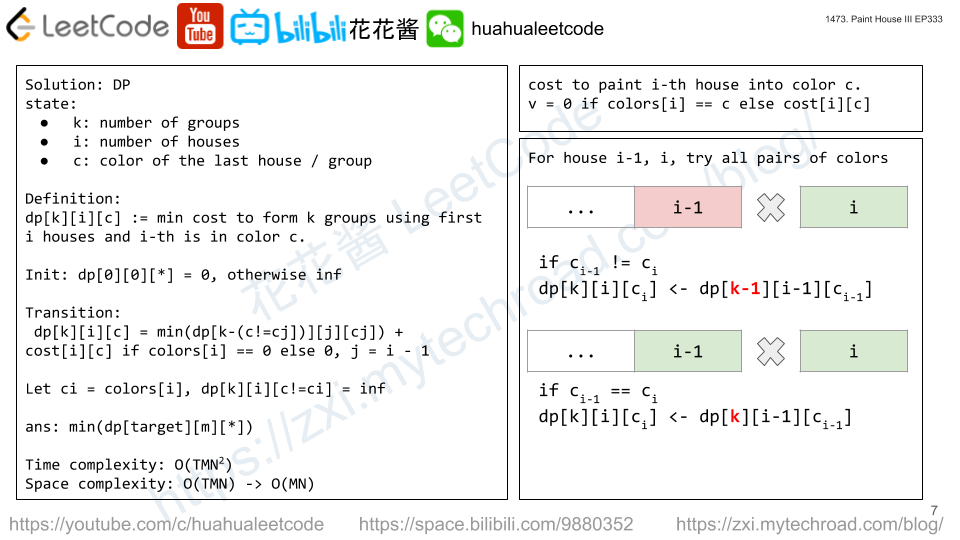There is a row of m houses in a small city, each house must be painted with one of the n colors (labeled from 1 to n), some houses that has been painted last summer should not be painted again.
A neighborhood is a maximal group of continuous houses that are painted with the same color. (For example: houses = [1,2,2,3,3,2,1,1] contains 5 neighborhoods [{1}, {2,2}, {3,3}, {2}, {1,1}]).
Given an array houses, an m * n matrix cost and an integer target where:
houses[i]: is the color of the housei, 0 if the house is not painted yet.cost[i][j]: is the cost of paint the houseiwith the colorj+1.
Return the minimum cost of painting all the remaining houses in such a way that there are exactly target neighborhoods, if not possible return -1.
Example 1:
Input: houses = [0,0,0,0,0], cost = [[1,10],[10,1],[10,1],[1,10],[5,1]], m = 5, n = 2, target = 3
Output: 9
Explanation: Paint houses of this way [1,2,2,1,1]
This array contains target = 3 neighborhoods, [{1}, {2,2}, {1,1}].
Cost of paint all houses (1 + 1 + 1 + 1 + 5) = 9.
Example 2:
Input: houses = [0,2,1,2,0], cost = [[1,10],[10,1],[10,1],[1,10],[5,1]], m = 5, n = 2, target = 3
Output: 11
Explanation: Some houses are already painted, Paint the houses of this way [2,2,1,2,2]
This array contains target = 3 neighborhoods, [{2,2}, {1}, {2,2}].
Cost of paint the first and last house (10 + 1) = 11.
Example 3:
Input: houses = [0,0,0,0,0], cost = [[1,10],[10,1],[1,10],[10,1],[1,10]], m = 5, n = 2, target = 5 Output: 5
Example 4:
Input: houses = [3,1,2,3], cost = [[1,1,1],[1,1,1],[1,1,1],[1,1,1]], m = 4, n = 3, target = 3
Output: -1
Explanation: Houses are already painted with a total of 4 neighborhoods [{3},{1},{2},{3}] different of target = 3.
Constraints:
m == houses.length == cost.lengthn == cost[i].length1 <= m <= 1001 <= n <= 201 <= target <= m0 <= houses[i] <= n1 <= cost[i][j] <= 10^4
Solution: DP

dp[k][i][c] := min cost to form k neighbors with first i houses and i-th house is in color c.
dp[k][i][c] := min{dp[k-(c != cj)][j][cj] for cj in 1..n} + 0 if houses[i] == c else cost[i][c]
init: dp[0][0][*] = 0 otherwise inf
ans = min(dp[target][m])
Time complexity: O(T*M*N^2)
Space complexity: O(T*M*N) -> O(M*N)
C++
|
1 2 3 4 5 6 7 8 9 10 11 12 13 14 15 16 17 18 19 20 21 22 23 24 25 |
// Author: Huahua // Author: Huahua, 104ms, 17.9MB class Solution { public: int minCost(vector<int>& houses, vector<vector<int>>& cost, int m, int n, int target) { constexpr int kInf = 1e9 + 7, s = 1; // dp[k][i][c] := min cost to form k neighbors with first i houses and end with color c. vector<vector<vector<int>>> dp(target + 1, vector<vector<int>>(m + 1, vector<int>(n + 1, kInf))); fill(begin(dp[0][0]), end(dp[0][0]), 0); for (int k = 1; k <= target; ++k) for (int i = k; i <= m; ++i) { const int hi = houses[i - 1]; const int hj = i >= 2 ? houses[i - 2] : 0; const auto& [si, ei] = hi ? tie(hi, hi) : tie(s, n); const auto& [sj, ej] = hj ? tie(hj, hj) : tie(s, n); for (int ci = si; ci <= ei; ++ci) { const int v = ci == hi ? 0 : cost[i - 1][ci - 1]; for (int cj = sj; cj <= ej; ++cj) dp[k][i][ci] = min(dp[k][i][ci], dp[k - (ci != cj)][i - 1][cj] + v); } } const int ans = *min_element(begin(dp[target][m]), end(dp[target][m])); return ans >= kInf ? -1 : ans; } }; |
请尊重作者的劳动成果,转载请注明出处!花花保留对文章/视频的所有权利。
如果您喜欢这篇文章/视频,欢迎您捐赠花花。
If you like my articles / videos, donations are welcome.



Be First to Comment